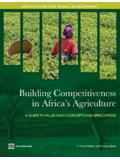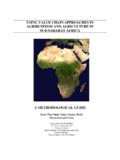Transcription of TNS BMGF Southern Africa Soy Roadmap - Zambia
1 Southern Africa Soy Roadmap . Zambia value chain analysis November 2010 February 2011. Executive summary (1/3). The Zambian soy market is self sufficient and growing rapidly with some exports, with production dominated by commercial farmers and considerable scope for production growth With production of 112k MT and consumption of 90k MT in 09/10, Zambia is a net exporter of soy, and has been so in the recent past Production has grown despite volatility as the market has grown; this has been largely achieved by increasing planting area rather than increasing yields 85% of this production is from commercial farmers In theory, there is no cap on production as Zambia has 33m HA available for additional production The price for soy beans has been volatile in the last 3 years, peaking at $200 above the SAFEX price in 2008 and tracking SAFEX since then.
2 This is partly due to currency fluctuations The cake market (90k in 09/10) has been driven by the growth of the poultry industry which drives demand for feed This is expected to continue, with the cake market rising to 194k MT domestic market by 2020, driven by a rise in demand from poultry from 65k MT today to 140k MT in 2020. The oil market is large enough to absorb all of the soy oil produced in the country - it is currently equivalent to 390k MT of soy beans, although recent imports of palm oil from East Africa which may breach COMESA may threaten the competitiveness of soy oil in the long term Zambia is well placed to export soy to Zimbabwe, South Africa and the DRC, but high transport costs and inconsistent policy limit traded volumes today to ~20k MT beans and ~10k MT cake Executive summary (2/3).
3 Despite a strong market and sufficient processing capacity, soy is a marginally attractive crop for commercial farmers due to a high cost base, poor transport infrastructure and an uncertain export policy; it is not an attractive crop for smallholders as they lack inputs, expertise and a market Commercial production: While Inputs are available, they are expensive as they are imported and finance is expensive Commercial farmers use the right inputs and have good agronomic practices giving and average yield of MT / ha However, at current cost of production ($398 / MT) and price ($350), soy is not a profitable crop for commercial farmers, with only the best farmers making money Smallholder production.
4 Smallholders struggle to obtain inputs as ago dealers do not stock them Smallholders use few inputs and have poor agronomic practices as this is a low priority crop compared with maize - they have yields of MT / ha smallholders struggle to find a market as they are not located in the main soy producing regions When total costs are considered for smallholders, soy is only an attractive crop as it increases yields for maize through rotation; however, when considering only cash costs, soy is very attractive Processing.
5 Zambia currently has good quality and excess processing capacity, with more coming on line - by the end of January, there will be 40% overcapacity, which would, in theory, allow Zambia to export soy cake (and sell the oil domestically), increasing the value retained in the country Most processors are vertically integrated into feed manufacturers to livestock companies, so their focus is more on making sure they meet their own feed demand Enabling environment: Government policy in maize makes soy less attractive to smallholders and trade policy makes producers less inclined to consistently target export markets High transport costs protect the country from imports but also reduce opportunities for exports and restricting the amount of land that is truly accessible for soy markets Executive summary (3/3).
6 Therefore, Zambia must make a number of improvements along the value chain to take advantage of the growing domestic market and export opportunities: Reduce production costs (particularly input, transport and finance costs). Improve smallholder agronomic practices Make trade policy consistent and transparent Ensure that palm oil imports adhere to COMESA rules Work with the private sector to stabilise the market for soy (particularly for smallholders). There is the potential to improve the lives of 133k smallholders by improving the soy value chain Improving the yield and market access for smallholders would increase the incomes of the 61k smallholders currently growing soy by $128 If this attracted 5% of smallholders not currently growing soy, it would benefit a further 62k smallholders Agenda The Zambian soy market is self sufficient and growing rapidly with some exports.
7 With production dominated by commercial farmers and considerable scope for production growth Despite a strong market and sufficient processing capacity, soy is a marginally attractive crop for commercial farmers due to a high cost base, poor transport infrastructure and an uncertain export policy; it is not an attractive crop for smallholders as they lack inputs, expertise and a market Therefore, Zambia must make a number of improvements along the value chain to take advantage of the growing domestic market and export opportunities.
8 There is the potential to improve the lives of 133k smallholders by improving the soy value chain Agenda The Zambian soy market is self sufficient and growing rapidly with some exports, with production dominated by commercial farmers and considerable scope for production growth Background Production Demand Trade Despite a strong market and sufficient processing capacity, soy is a marginally attractive crop for commercial farmers due to a high cost base, poor transport infrastructure and an uncertain export policy.
9 It is not an attractive crop for smallholders as they lack inputs, expertise and a market Therefore, Zambia must make a number of improvements along the value chain to take advantage of the growing domestic market and export opportunities: There is the potential to improve the lives of 133k smallholders by improving the soy value chain Zambia is a land-locked, sparsely populated country in the central African plateau Geography Landlocked country in with an area of ~750,000 sq km in the central African plateau With the Zambezi, Kafue, and Luangwa rivers, Zambia accounts for over 40% of Southern Africa 's water reserves People Zambia 's population is ~ (2006)
10 With a growth rate of slowing to due to HIV/AIDs 38% of Zambians live in urban areas More than 70 ethnic groups coexist peacefully Politics Zambia gained independence in 1964 from the United Kingdom The Movement for Multiparty Democracy (MMD) party has held power since 1991. Zambia exhibits strong support for the role of democracy and relatively free press Economy Copper is Zambia 's biggest export (70% of export earnings) and contributes ~10% to GDP. Most Zambians work in agriculture, which accounted for of GDP in 2007.




